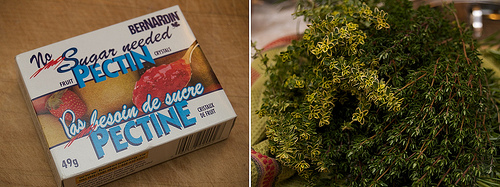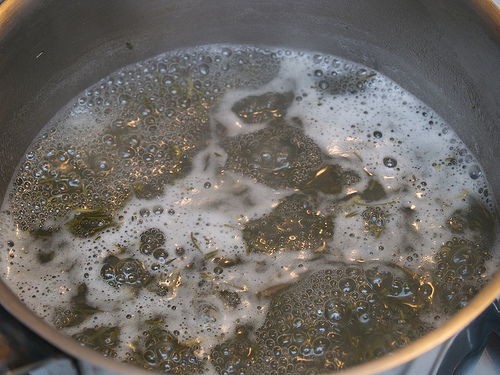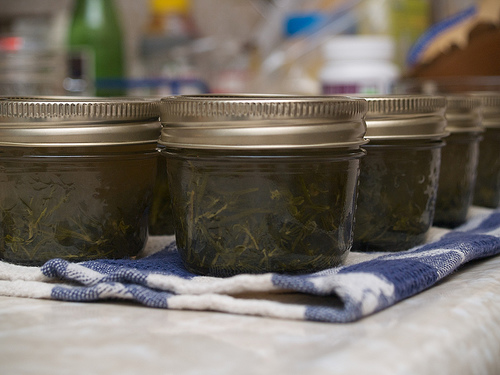
Well if today is any indication, winter is practically upon us (what the hey?? SNOW??). But I have a couple more canning tricks up my sleeve.
A few years ago I made a white wine and herb jelly which is really lovely for using as a glaze on roasted meats, or to serve with a cheese platter. I have an abundance of herbs this year and with frost around the corner, I wanted to do something different with them.
I couldn’t find the original recipe I used so long ago so I’ve modified one from the Bernardin Home Guide to Preserving, a book I’ve found incredibly useful and informative when it comes to canning. I highly recommend it (its like $8, and available in lots of places and online).

White Wine & Herb Jelly
(adapted from the recipe for Herb Jelly in the Bernardin Guide to Home Preserving)
- 1 large bunch of your favourite herbs (I used lemon thyme, regular thyme and rosemary); leaves removed from stem if you plan to leave the herbs in the jelly as I did – or leave on the stem if you intend to strain the herbs from the finished jelly
- 3 3/4 cups of white wine
- 1 package of Bernardin No Sugar Needed Pectin
Wash the herbs and spin dry to remove access moisture. Combine herbs with wine in a stainless steel pot and steep for about 20 to 30 minutes to infuse the wine with the herb flavours. If you prefer a clear jelly, use a sieve to strain the herbs from the liquid (I left mine in because I think they look pretty). Measure 3 1/2 cups of liquid (and herbs if keeping them in) back into the pot and whisk in the pectin. Return to a full, rolling boil, and boil for one minute.
Ladle into hot, sterilized jars, leaving about 1 cm of space from the rim. Using a non-metal utensil remove any air bubbles. If necessary, wipe the rims to remove any spillage and to ensure a clean seal. Centre snap lids on jar and place the band on the jar, lightly. Process jars in a boiling water canner and boil for 10 minutes. Remove jars from the water and allow to cool. Any jars that don’t “pop” down are not vacuum sealed (don’t worry, it happens), and should be frozen or refrigerated and used soon.
Makes approximately 3 x 250 ml jars, or 6 x 125 ml jars.
Note: Never try to double a jelly recipe. I actually did make a double batch, but I boiled the liquid in two batches each with one package of pectin. I don’t know why but jelly can be finicky and you can risk having a whole batch not set properly if you mess around. I ended up with a whole batch of Elderberry syrup last year that was supposed to be jelly!

I have questions! It certainly doesn’t seem like there is enough boiling time to remove the alcohol from the wine, can you confirm this? I like my wine jelly to keep it’s alcohol level. Also, I see there is no sugar in this recipe. All wine jellies I’ve tried are quite sweet, and I like them this way. Do you think the wine itself is sweet enough? Suppose I like it sweeter…would I need to use a different pectin (rather than this no sugar type)?
I’m unfamiliar with making jellies and jams and canning in general, so forgive me if the questions are obvious!
I think the simmering time is more about infusing the liquid with the herbs, not so much about boiling off the alcohol, but I can’t really confirm the final alcohol content of the jelly. I can tell you that my jelly tastes VERY herby, but you can still taste the wine. I think you can definitely adjust it for less time if you prefer it.
As for the sugar, this is a low-sugar recipe. I say low-sugar, because the no-sugar-needed pectin is sweetened slightly with dextrose. This means the jelly still has a somewhat sweet taste, but it’s not as sugary as full sugar jelly. I found this recipe on the Bernardin site for a full sugar herb jelly in which you can probably substitute the liquid (juice and water) with wine. Also note however, that this recipe has vinegar, which you may not want (I’m not sure how the wine and vinegar together would taste). I also found another white wine and herb jelly recipe that uses full sugar and liquid pectin. I haven’t tried either of these recipes so I can’t vouch for them (I really wish I could find that recipe I used so long ago!).
Note that you should try to use the type of pectin specified in a recipe. From what I understand, original, powdered pectin is best for cooked jams and jellies, whereas the liquid pectin, while it can be used in some cooked jam recipes, has been developed to help speed the jam-making process (aimed to appeal to today’s fast-paced lifestyle, I suppose) and is especially great for freezer jam, since it’s already pre-dissolved. No-Sugar-Added pectin is a newer product, and is especially good for people living with diabetes or have other sugar sensitivities. I’ve made other kinds of fruit jams with it and I really like it.
To avoid problems with jams and jellies not setting properly, I strongly recommend using whatever pectin the recipe calls for, and stick to the quantities specified for fruits and liquids. It’s a heck of a lot of work to put into it to have your jelly turn out more like a syrup!
Thank you, this is great information! I should clarify and say that I need the jelly to *taste* like it’s got alcohol in it; the actual level doesn’t matter, so I’m sure your recipe would work wonderfully for that. I think I’ll try your recipe first, see what I think of the sugar content, and then go from there. And that’s IF I can organize myself to even get started. Thanks again. 🙂
I was given some herb wine jelly and would like to know what to serve it with. It isn’t sweet as most jellies are so it doesn’t work on toast or pancakes. Would it work over cream cheese as an appetizer? What other ways do you serve it?
You can use it as a glaze on roasted meats, or serve it with roasted meat (like you would with mint jelly and lamb). With cream cheese is great, or with any cheese really; many wine jellies make a great compliment to a cheese tray. Enjoy!
In the recipes you mentioned measure 3 1/2 cups of liquid. Does this mean I should add water?
Hi Martha, No actually. If you have less liquid from steeping the herbs, I would just use all of your liquid. I wouldn’t add water to it at that point. You should however have more liquid than 3 1/2 cups from the steeping. The reason you measure out 3 1/2 cups and no more is so that your jelly will set with the amount of pectin you’re using. Good luck!